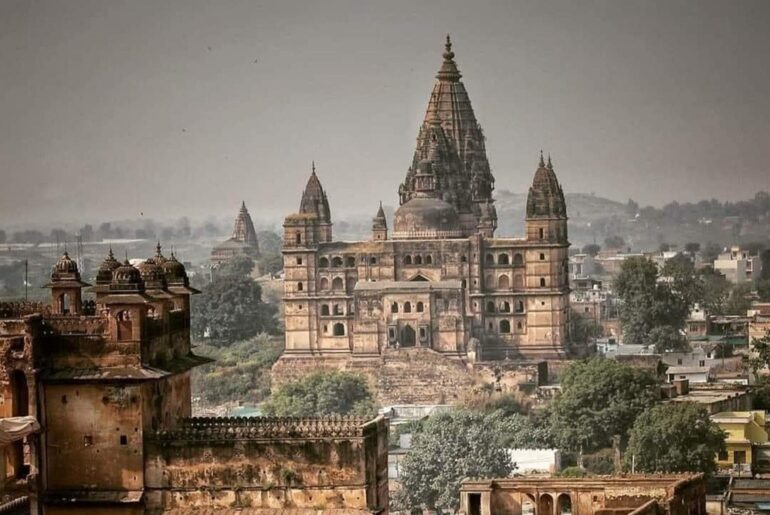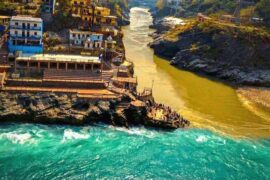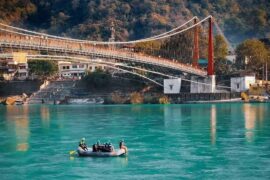All about Orchha Chaturbhuj Temple: A Blend of Fort and Palace
Orchha Chaturbhuj Temple,
Located 1 km from Orchha Fort and near the Ram Raja Mandir, the Chaturbhuj Temple is an ancient Hindu shrine known for its stunning architecture. It is one of the most notable heritage landmarks in Orchha, Madhya Pradesh, and falls under the preservation of the Archaeological Survey of India.
Historical Significance
The name Chaturbhuj, meaning “one who has four arms,” refers to Lord Rama, an incarnation of Lord Vishnu. The temple was constructed by Raja Madhukar Shah between 1558 and 1573 for his wife, Rani Ganesh Kuwari, a devout follower of Lord Rama.
According to legend, Rani Ganesh Kuwari dreamt of Lord Rama, who instructed her to build a temple for him. She brought an idol of Lord Rama from Ayodhya, intending to enshrine it in the temple.
However, the idol, kept temporarily in the Rani Mahal, refused to be relocated to the newly built Chaturbhuj Temple. Consequently, an idol of Lord Vishnu with four arms was installed instead, and the temple was named Chaturbhuj Temple.
Architectural Splendor Orchha Chaturbhuj Temple
The Orccha Chaturbhuj Temple is an exquisite blend of temple, fort, and palace architecture.
- Exterior: The temple resembles a multi-storied palace with large arcaded openings, a grand central tower, a massive entrance, and fortified walls. Lotus motifs and religious symbols adorn its intricate facade.
- Interior: The sanctum is starkly plain, with high, vaulted walls that emphasize its sanctity.
- Location: Built atop a stone platform, the temple is accessed via a steep flight of stairs.
Visiting Information Orchha Chaturbhuj Temple
- Orchha Chaturbhuj Temple Timings: 9 AM – 5 PM
- Orchha Chaturbhuj Temple Entry Fee: Included in the Fort Complex Entry Fee
Highlights ( Orchha Chaturbhuj Temple )
- Architectural Style: Combines elements of religious, fort-like, and palace designs.
- Historical Legend: Reflects the devotion and vision of Orchha’s rulers.
- Religious Symbolism: Dedicated to Lord Vishnu, featuring intricate carvings and spiritual significance.
Suggested Read: Discover Orchha Waterfall at Barua Sagar Near Orchha Town

Chaturbhuj Temple Orchha Chaturbhuj Temple
The Chaturbhuj Temple, located at the heart of Orchha, stands as a monumental marvel, dominating the village skyline unlike any other temple in India. Its towering shikaras, shaped like pinecones, seem to soar into the sky, creating an awe-inspiring sight reminiscent of ancient skyscrapers.
Historical Context Orchha Chaturbhuj Temple
Construction of the temple began in 1558, commissioned by Raja Madhukar Shah for his devout wife, Rani Ganesh Kunwari, to honor her profound devotion to Lord Rama. However, the temple’s completion was overseen by their son, Vir Singh Deo, solidifying its legacy across generations.
Architectural Grandeur Orchha Chaturbhuj Temple
- The temple’s towering structure reflects its monumental significance.
- Its intricate facade, combined with the imposing height, makes it a unique blend of artistic and architectural brilliance.
- The shikaras, resembling pinecones, are the temple’s most iconic feature, symbolizing a celestial connection.
Chaturbhuj’s Architectural Style
The Chaturbhuj Temple is a masterpiece of design, blending intricate religious artistry with simplicity.
Exterior Beauty Orchha Chaturbhuj Temple
- The temple’s exterior walls are adorned with detailed religious symbols and elegant lotus motifs, showcasing the skilled craftsmanship of its creators. These decorations imbue the structure with spiritual significance and aesthetic appeal, reflecting the artistic heritage of the Bundela dynasty.
Interior Simplicity Orchha Chaturbhuj Temple
- In stark contrast to its ornate exterior, the temple’s interior is notably austere, emphasizing functionality and reverence over decoration. This contrast enhances the visitor’s experience, creating a sense of solemnity within the grandiose structure.
Madhukar Shah’s decision to build the Chaturbhuj Temple on such a grand scale for his wife, Rani Ganesh Kunwari, stems from a profound blend of devotion, legend, and royal ambition.
The Local Legend Chaturbhuj Temple
According to folklore, one night, Rani Ganesh Kunwari experienced a divine dream in which Lord Rama appeared and instructed her to build a temple in his honor. Inspired by her dream and her unwavering devotion to Lord Rama, she conveyed her vision to her husband, Madhukar Shah. Moved by his wife’s spiritual fervor, the king approved the construction of a temple befitting the deity’s stature.
A Royal Gesture of Devotion
- The grandeur of the temple reflects not just an act of devotion but also the king’s desire to honor his wife’s faith in a way that resonated with their kingdom’s spiritual and cultural ethos.
- By building the temple on such an awe-inspiring scale, Madhukar Shah sought to create a symbol of both divine reverence and royal legacy.
The Queen’s Pilgrimage
While the temple was under construction, Rani Ganesh Kunwari embarked on a pilgrimage to Ayodhya, the birthplace of Lord Rama, to bring back an image of the deity. The image was intended to be enshrined in the Chaturbhuj Temple, solidifying its purpose as a sacred abode for Lord Rama.
The Story Behind Orccha Chaturbhuj Temple
The story of the Chaturbhuj Temple takes an intriguing turn, blending divine legend with architectural grandeur and cultural adaptation. Upon Rani Ganesh Kunwari’s return from Ayodhya with the idol of Lord Rama, the temple was still under construction—a testament to the scale and complexity of the project, which likely spanned decades.
The Reluctant Idol
In the interim, the idol of Lord Rama was placed in the Rani Mahal, the queen’s palace adjacent to the Chaturbhuj Temple. Upon the temple’s completion, attempts were made to ceremoniously move the idol to the new sanctum.
However, legend has it that the idol “refused” to be relocated—perhaps symbolizing divine will or local faith. This unmovable presence led to the transformation of the Rani Mahal into the Ram Raja Temple, a unique place of worship where Lord Rama is venerated as a king rather than a deity.
The Temple’s Role Today
With the Ram Raja idol remaining in the palace, the Chaturbhuj Temple took on a new identity. It now houses an image of Radheykrishan (Radha and Krishna). Despite this shift in purpose, the temple remains a majestic symbol of devotion and architectural ingenuity.
Architectural Insights
- Interior Grandeur: The interior is as impressive as the towering exterior, showcasing its intricate cross-shaped layout, symbolizing the four arms of Lord Rama (Chatur = Four, Bhuj = Arms).
- Western Basilica Influence: The structure mirrors the design of a western Basilica, with its elongated floor plan and intersecting halls.
My Experience visiting temple
The Chaturbhuj Temple offers not just a ground-level exploration but also the chance to ascend to its upper galleries and roof—if you’re up for a little adventure. Here’s what to expect and some tips if you decide to take on this climb:
Climbing to the Roof
- Unplanned and Informal Access: Access to the temple’s higher levels seems to be an unofficial arrangement, often facilitated by locals or children who hang around the entrance.
- Guided Ascent: If you find someone willing to guide you, it’s customary to offer a small tip as a token of appreciation. However, expect the climb to be rushed and informal.
The Ascent Experience
- Dark and Steep Staircases: By torchlight, you’ll navigate narrow, steep steps, some nearly a meter high, making the climb both challenging and thrilling.
- Two-Stage Climb: The ascent is often divided into stages—first to an upper gallery and then to the roof itself.
The Views Orchha Chaturbhuj Temple
- Interior Views: From the gallery, you can admire the intricate interior of the temple, including its carved walls and cross-shaped layout.
- Exterior Vistas: On the roof, you’ll be treated to sweeping views of Orchha, encompassing the Ram Raja Temple, the Betwa River, and other nearby monuments. The carved window apertures provide framed views that are a photographer’s delight.
Health and Safety Warnings
- Hazards: The staircases are dangerously dark, with uneven, crumbling masonry. The steps are inadequately spaced for modern safety standards.
- Preparation: Wear sturdy shoes, bring a reliable flashlight, and exercise caution during the climb.
Stunning Views from the Roof
- Panoramic Views: From the roof, you can enjoy spectacular panoramic views of Orchha. The Betwa River meanders gracefully, while you also get a bird’s-eye view of the Ram Raja Temple, Orchha Fort, and a cluster of other temples and chattris. The entire town is laid out before you in a perfect blend of heritage and nature.
- Look Up for Indian Vultures: If you’re lucky, you might spot Indian vultures soaring overhead or perched on the temple’s towering pinnacles. Unfortunately, these magnificent creatures have seen a dramatic population decline, but Orchha remains one of the few places where you can still catch a glimpse of them.
Golden Towers and a Tale of Robbery
- Golden Towers: Two stories surround the golden aspect of the Chaturbhuj Temple. One legend says the towers were once encased entirely in gold, which was stolen over time. Another, more plausible story suggests that Madhukar Shah placed a kalasha, made of over 100 pounds of pure gold, atop the temple—but even that was eventually looted.
- Historical Significance: This gold-related legend adds a layer of mystique to the temple, further enriching its history and symbolism.
Roof Experience & Sunset Potential
- Short but Sweet: The time on the roof is brief, but it’s enough to capture the beauty of Orchha from above. While the sunset view would be extraordinary from this height, it’s important to check the timings, as the ascent and descent could be restricted.
- Additional Views: As you descend, the upper gallery provides additional views of the interior of the temple, adding another dimension to your experience.
Final Thoughts
- Nighttime Illuminations: If you’re staying outside Orchha, don’t miss a visit to the village center in the early evening. The temples, including Chaturbhuj, are beautifully illuminated at night, adding an atmospheric touch to their already impressive presence. The temple truly dominates the landscape, making for a stunning sight at any time of the day, but particularly when lit up after dark.
Conclusion Orchha Chaturbhuj Temple
Overall, a visit to the Chaturbhuj Temple is more than just a historical exploration—it’s an adventure that offers striking views, fascinating stories, and a deeper connection to Orchha’s heritage. If you’re able, the climb to the roof is highly recommended, adding a rewarding twist to your visit.
Architectural Insights
Magnificent Chaturbhuj Temple
- The town of Orchha is marked by the towering presence of the Chaturbhuj Temple, a structure that dominates the skyline with its grandeur. Built on an elevated podium rising approximately 15 feet high, the temple’s majestic Shikharas (spires) seem to pierce the sky, offering a breathtaking sight.
Access and Location
- Visitors must climb a broad flight of stairs to reach the temple’s entrance, emphasizing its elevated and commanding position. Located south of the Ram Raja Temple, the Chaturbhuj Temple was initially intended to house an idol of Lord Ram. However, this plan did not materialize, and the temple now enshrines an idol of Radhey Krishna, adding a unique aspect to its legacy.
Construction and History
- The construction of this architectural wonder began under the reign of Madhukar Shah, one of Orchha’s Bundela rulers. However, the temple was completed only during the reign of his son, Bir Singh Deo, showcasing the dedication and vision of the royal lineage.
The Temple’s Noble History
- The Chaturbhuj Temple holds a profound connection to Lord Rama, an avatar of Vishnu, whose name and symbolic representation are deeply embedded in the temple’s design.
Etymology and Symbolism
- The name Chaturbhuj translates to “one who has four arms”, combining “Chatur” (four) and “Bhuj” (arms). This symbolism is reflected in the temple’s four spires, which reach skyward, echoing the divine form of Vishnu. The layout of the temple also represents the outstretched arms of the deity, creating a visual and spiritual connection for worshippers.
Royal Vision and Inspiration
- Legend has it that Rani Ganeshkuwari, the queen of Madhukar Shah, initiated the temple’s construction. According to folklore, Lord Rama appeared in her dream and commanded her to build this sacred space. Her devotion and vision laid the foundation for this architectural marvel.
Architectural Tribute
- Historian K.K. Chakravarty beautifully compares the temple’s design to the traditional image of Lord Vishnu, with his four arms extending outward. The basilica-shaped structure, central vestibule, and intersecting assembly halls form a harmonious and majestic layout. The pinecone-shaped spires, reaching for the heavens, further enhance the temple’s grandeur and spiritual significance.
Imposing Facade of Chaturbhuj Temple
- The Chaturbhuj Temple boasts an architectural plan resembling a basilica, as described by Indian art historian K.K. Chakravarty. Its assembly hall, aligned at perfect right angles to its vestibules, creates a symmetrical and functional layout that emphasizes its grandeur.
Golden Past and Majestic Views
- In its prime, the temple’s spires were clad in gold, lending a dazzling brilliance to the structure. Unfortunately, time has eroded this splendor, leaving behind a majestic but weathered facade. Visitors can climb to the temple’s roof, which offers sweeping views of Orchha’s landmarks:
- The Ram Raja Temple Orchha Chaturbhuj Temple
- The rambling Betwa River Orchha Chaturbhuj Temple
- The fascinating Sawan Bhadon structures
- The impressive Laxminarayan Temple
Challenging Ascent
- Ascending to the roof is an adventure in itself. The crumbling stairs, steep and narrow with minimal foot space, number sixty-seven in total. The dark and windswept climb demands caution, but the breathtaking views reward those who make the effort.
Preservation and Management
- Today, the State Archeological Department oversees the temple’s preservation, ensuring its architectural integrity is maintained for future generations. Meanwhile, the Ram Raja Trust manages its daily operations, balancing heritage conservation with accessibility for visitors and devotees.
Orchha Chaturbhuj Temple Orchha Chaturbhuj Temple Orchha Chaturbhuj Temple Orchha Chaturbhuj Temple Orchha Chaturbhuj Temple Orchha Chaturbhuj Temple Orchha Chaturbhuj Temple Orchha Chaturbhuj Temple




Comments are closed.